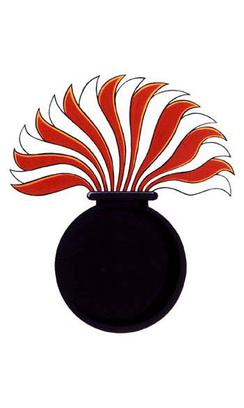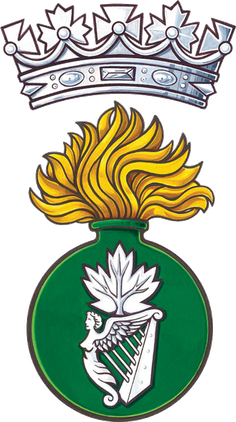
The 1st Canadian Division is a joint operational command and control formation based at CFB Kingston, and falls under Canadian Joint Operations Command. It is a high-readiness unit, able to move on very short notice, and is staffed and equipped to meet Canada’s military objectives to counter any potential threat.

The Winnipeg Grenadiers was an infantry regiment of the Canadian Army.
The 13th Battalion (Royal Highlanders of Canada) of the Canadian Expeditionary Force was an active service battalion during the First World War.

The 7th Battalion, CEF was a battalion of the Canadian Expeditionary Force that saw service in the First World War.
The 1st Canadian Infantry Brigade was a Canadian Army formation that served with the 1st Canadian Division in World Wars I and II. In 1953 it was reformed in Germany to become the 1 Canadian Mechanized Brigade Group in 1992.
The Winnipeg Light Infantry was an infantry regiment of the Non-Permanent Active Militia of the Canadian Militia. In 1955, the regiment was amalgamated with The Royal Winnipeg Rifles.
The Edmonton Fusiliers was an infantry regiment of the Non-Permanent Active Militia of the Canadian Militia and later the Canadian Army. First raised in 1908 as part of the 101st Regiment Edmonton Fusiliers, it became a separate regiment in 1924 when The Edmonton Regiment was split into two separate regiments. In 1946, the regiment was Amalgamated with the 19th Alberta Dragoons.

The 5th Battalion, CEF, known as "Tuxford's Dandys," was an infantry battalion of the Canadian Expeditionary Force during the Great War.
The Canadian Fusiliers (City of London Regiment) was an infantry regiment of the Non-Permanent Active Militia of the Canadian Militia (now the Canadian Army). In 1954, the regiment was amalgamated with The Oxford Rifles to form The London and Oxford Fusiliers (now the reserve battalion of the Royal Canadian Regiment).

The Irish Fusiliers of Canada (The Vancouver Regiment) was an infantry regiment of the Canadian Army. It was placed on the Supplementary Order of Battle in 1965. In 2002, it was taken off the Supplementary Order of Battle and amalgamated with The British Columbia Regiment (Duke of Connaught's Own).

The 8th Battalion, CEF, also known by the nickname of The Little Black Devils of Canada, was an infantry battalion of the Canadian Expeditionary Force during the Great War. The battalion was authorized on 10 August 1914 and embarked for Great Britain on 1 October 1914. It disembarked in France on 13 February 1915, where it fought as part of the 2nd Canadian Brigade, 1st Canadian Division in France and Flanders until the end of the war. The battalion was disbanded on 15 September 1920.
The Oxford Rifles were an infantry regiment of the Non-Permanent Active Militia of the Canadian Militia. In 1954, the regiment was amalgamated with The Canadian Fusiliers to form The London and Oxford Fusiliers.
The Peterborough Rangers was an infantry regiment of the Non-Permanent Active Militia of the Canadian Militia. In 1936, the regiment was amalgamated with the 3rd Prince of Wales' Canadian Dragoons to form The Prince of Wales Rangers.
The Saint John Fusiliers was an infantry regiment of the Non-Permanent Active Militia of the Canadian Militia. In 1946, the regiment was amalgamated with The New Brunswick Rangers to form the South New Brunswick Regiment which was later renamed as The New Brunswick Scottish. They now form part of the 1st Battalion, The Royal New Brunswick Regiment.
The Colchester and Hants Regiment was an infantry regiment of the Non-Permanent Active Militia of the Canadian Militia. In 1936, it was amalgamated with The Cumberland Highlanders to create The North Nova Scotia Highlanders.
The North Saskatchewan Regiment was a short-lived infantry regiment of the Non-Permanent Active Militia of the Canadian Militia. In 1924, the regiment was reorganized and split up into 4 separate regiments.
The Saskatchewan Mounted Rifles was a cavalry regiment of the Non-Permanent Active Militia of the Canadian Militia. First formed in 1908 as the Saskatchewan Light Horse, the regiment was later redesignated that year as the 22nd Saskatchewan Light Horse and again in 1920 as The Saskatchewan Mounted Rifles. In 1911, the regiment transferred two of its squadrons to the newly formed 29th Light Horse. In 1936, the regiment was amalgamated with the 16th Canadian Light Horse to form the 16th/22nd Saskatchewan Horse.
The South Saskatchewan Regiment was a short-lived infantry regiment of the Non-Permanent Active Militia of the Canadian Militia. In 1924, the regiment was reorganized and split up into 5 separate regiments.
The 13th Canadian Infantry Brigade was a formation of the Canadian Army that served in both World Wars. During World War I, the brigade formed part of the 5th Canadian Division. However, the 13th Brigade never saw combat as the brigade along with the 5th Canadian Division was broken up to provide reinforcements to the 4 other divisions of the Canadian Corps. During the Second World War, the brigade formed part of the 6th Canadian Infantry Division serving on the west coast in the home defence role and in June 1943, the brigade took part in Operation Cottage on Kiska during the Aleutian Islands campaign.
The 11th Canadian Infantry Brigade was a brigade-sized infantry formation of the Canadian Army which saw service in both World Wars. During the First World War, the brigade formed part of the 4th Canadian Division where it served on the Western Front as part of the Canadian Corps. During the Second World War, the brigade served this time as part of the 5th Canadian (Armoured) Division of the I Canadian Corps in the Italian Campaign and later in North-West Europe along with the rest of the First Canadian Army.





